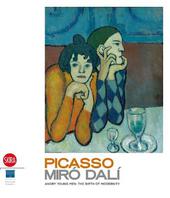
|
Picasso, Miro, Dali: Angry Young Men: The Birth of Modernity
Hardback
Main Details
| Title |
Picasso, Miro, Dali: Angry Young Men: The Birth of Modernity
|
| Authors and Contributors |
By (author) Eugenio Carmona
|
| Physical Properties |
| Format:Hardback | | Pages:208 | | Dimensions(mm): Height 278,Width 237 |
|
| Category/Genre | Art and design styles - c 1900 to c 1960 |
|---|
| ISBN/Barcode |
9788857209784
|
| Classifications | Dewey:709.04 |
|---|
| Audience | |
|---|
| Illustrations |
Illustrated in colour throughout
|
|
Publishing Details |
| Publisher |
Skira
|
| Imprint |
Skira
|
| Publication Date |
3 October 2011 |
| Publication Country |
Italy
|
Description
This is the birth of modernity as seen through sixty stunning early works by three of the greatest artists of all times. This catalogue begins by examining Picassos pre-cubist period, between 1900 and 1905, while closely contrasting works created by Juan Miro between 1915 and 1920 with those by Salvador Dali in the five-year period between 1920-1925, in order to highlight the differences and stylistic relationships marking the period prior to the two artists adherence to Surrealist poetics. In order to enquire into particular aspects of the early production of these artists, the authors have chosen works rarely exhibited in public or published; yet these fascinating paintings influenced what was to come, and they include "The Spanish Dancer" from 1901 by Picasso, "Threshing" by Miro from 1918, and "Neo-cubist academy" by Dali, which dates from 1926. Picassos early work is profoundly influenced by the artists political convictions: in Madrid in 1901 Picasso founded the magazine "Arte Joven", which frequently published unforgiving images of the plight of the proletariat. As for Miro, he rejected figurative painting as an expression of the cultural identity of the governing classes and also saw cubism as a political tool. Much younger than Picasso and Miro, Dali was ousted from the Academy in 1926, shortly prior to undertaking final examinations, for having declared that no one in the faculty was sufficiently competent to examine him. His early work is marked by a complete mastery of pictorial techniques, an example is "Girl at the window" from 1926, depicted with vivid realism.
Author Biography
The curator Cristoph Vitali was director of the Schirn Kunsthalle in Frankfurt, the Haus der Kunst in Munich, the Beyeler Foundation in Basel, and the German Federal Republic Art and Exhibition Hall in Bonn. Eugenio Carmona, who is a well-known art historian, is a specialist in Spanish modern art.
|